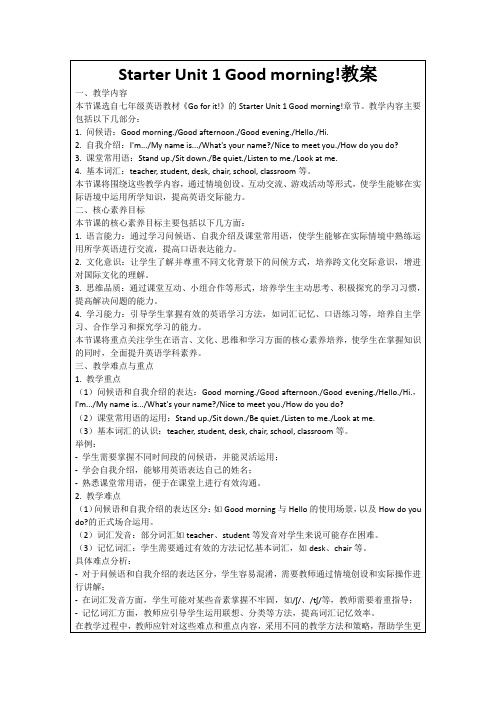最新Starter Unit 1 全单元教案
Starter Unit1 1a-1c教案 人教版七年级上册英语

Greet Ss with“Good morning”.
T: Hi / Hello, … (板书hi, hello)
Use“Hi!”and Hello!”to greet Ss.
Step 5: Listening (1b)
Get Ss to listen and repeat.(录音1b)Ask them to pay attention to the pronunciation and intonation.
设计意图:输入性听力跟读,强调模仿语音、语调。
Step 6: Pair work (1c)
教学设计
设计人:_____ _______所在单位:____ _____
教材
人教版新目标(Go for it!)
年级
七年级上册
单元及内容
Starter Unit1 Good morning!
1a-1c
课型
听说课
1.教学内容分析
本课时是单元的第一课,通过听、说活动让学生巩固、运用问候的表达法。1a通过图文导入本单元的话题,并呈现表示问候的语言功能,以及以Aa-Hh为首的8个常见英文名字。1b通过听力输入的方式呈现了Hi./ Hello. / Good morning.三种问候表达法。1c让学生模仿录音并进行控制性的语言输出。
1. Ask Ss to practice the conversations in the picture one by one.(ppt-7)
2. Ask Ss to greettheirpartner freely.(ppt-8)
StarterUnit1(3a-4d)教案

举例:教师可以通过展示不同颜色的物品,让学生用英语进行描述,巩固颜色词汇的学习。
(4)表达喜好:学习如何用英语表达个人喜好,如“I like...”。教师应着重强调这一知识点,使学生能够表达自己的兴趣爱好。
3.成果分享:每个小组将选择一名代表来分享他们的讨论成果。这些成果将被记录在黑板上或投影仪上,以便全班都能看到。
(五)总结回顾(用时5分钟)
今天的学习,我们了解了英语问候语和自我介绍的基本概念、重要性和应用。同时,我们也通过实践活动和小组讨论加深了对这些知识点的理解。我希望大家能够掌握这些知识点,并在日常生活中灵活运用。最后,如果有任何疑问或不明白的地方,请随时向我提问。
(2)自我介绍的流畅性:学生在进行自我介绍时,可能会出现紧张、不自信等情况,导致表达不流畅。
方法:教师可以多给予学生练习的机会,并进行鼓励和指导,帮助他们建立自信,提高自我介绍的流畅性。
(3)颜色词汇的识别与运用:对于部分学生来说,颜色词汇的识别和运用可能存在一定难度。
方法:教师可以设计有趣的颜色游戏,如“找出相同颜色的物品”、“颜色接龙”等,帮助学生巩固颜色词汇。
Starter Unit 1 (3a-4d)教案
一、教学内容
《Starter Unit .章节内容:本节课选取英语教材的起始单元,重点教授3a-4d部分。
a. 3a:介绍基本的问候语,如“Hello!”、“Hi!”、“Good morning!”等。
b. 3b:学习简单的自我介绍,如“My name is...”。
五、教学反思
在今天的教学过程中,我发现学生们对于英语问候语和自我介绍的学习非常感兴趣。他们积极参与课堂活动,尤其是实践活动和小组讨论环节,表现出了很高的热情。以下是我对今天教学的几点反思:
Starter-Unit1教案

(2)Starter Unit1 Good morning!单元知识结构1.Topic: Meet friends.2.Functions: Greet people.3.Structures: Letters: A—H, Pronunciation of letters A—H.单元学习目标1、知识与能力①V ocabulary: A a—H h, hi, hello, good, morning…②Target language: Good morning, Alice! Good morning, Cindy! Hello, Frank! Hi, Cindy! How are you? I’m fine, thanks. How are you? I’m OK.2、过程与方法Listening. Speaking. Reading. Writing.3、情感、态度、价值观通过运用日常交际用语,来培养学生对英语的兴趣,使学生体会到英语文化的氛围。
4、学习重点①Letters: A—H的发音和正确书写.②会熟练运用问候语:Good morning! Hello! How are you? I’m fine, thanks!课题Starter Unit 1 Good morning! 课时第1课时课堂检测Exercises1.写出字母A---H的大小写。
2.写出下列字母的相邻字母Bb CcFf EeGg Dd3.下列字母中的是元音字母。
A.Cc B.Bb C.Ee D.Dd4.与字母F笔画一样多的是_________ 。
A. BB. dC. ED. G5.下列字母代表英国广播公司的是_________ 。
A. HBB. CDC. BBCD. ABC6.光盘缩写为。
A.HB B.kg C.BBC D.CD7.将下列字母按所含的相同音素归类。
Aa Bb Cc Dd Ee Gg Hh/eI/ ______ ______/i: / _______ ______ ______ ______ ______(3)课题Starter Unit 1 Good morning! 课时第2课时教学目标1.To learn eight persons’ name.2.To master some new words: good, morning, hi, hello, afternoon,evening…3.To learn how to greet people.教学重点To master some new words: good, morning, hi, hello, afternoon…To learn to greet people.教学难点To master some new words: good, morning, hi, hello, afternoon…To learn to greet people.。
Starter Unit 1 教案(共计10页)

StarterUnit1Goodmorning!一、单元教材分析本单元要求学生掌握英文字母A—H,能认读其印刷体和手写体字母的大小写等四种形式。
书写(大写和小写,笔顺,笔画)基本合乎要求。
学习一些简单的英文名字,注意区别性别,并为自己取一个英文名字。
能看、听、说、唱本单元所列的日常交际用语,重点学会打招呼、相互问候并做到语音语调正确。
注意一些字母及日常交际用语的发音,总结元音字母a和e的发音规则。
二、单元学情分析本单元围绕“问候他人”这一话题,展开听、说、读、写的教学活动。
为了创设较为真实的语言环境,首先让学生们认识一些较为简单的英文名字,并让学生们为自己取一个英文名字,让学生们感知、认识英语,并尽快进入英语的环境中。
在教学过程中应让学生体会打招呼用语的奥妙所在,做到灵活运用。
刚开始学习英语,学生们肯定对学习英语的兴趣非常深厚,教师一定要利用好这一点,让学生在学习英语中能获得乐趣。
并逐步让学生们形成稳定的学习兴趣。
三、单元教学建议采用自主学习、小组合作学习、Roleplaying、pairwork等方式开展听、说、读、写的学习活动。
教师要尽量利用幻灯片、挂图、实物等给学生创造较为真实的英语情景。
在教学中创设切实可行的任务型教学活动、突出交际性。
引趣激趣策略,创设情景调节气氛,引发激发学生兴趣。
教师可以用手势,表情,动作等示意,帮助学生听懂课堂用语和日常交际用语,不讲或少讲汉语。
四、单元课时分配本单元可用2课时完成教学任务:(1a-2e)用1课时(3a-4d)用1课时(1a-2d)一、教学目标:1.语言知识目标:1)能掌握以下词汇:字母Aa~Hh,good,morning,Goodmorning!,hi,hello2)能掌握以下句型:①Goodmorning,Helen!②Hello,Frank!③Hi,Bob!3)能理解用英语打招呼的不同说法,并能灵活运用。
4)能掌握字母Aa~Hh的字母顺序,读音及书写。
StarterUnit1Goodmorning!教案

1.理论介绍:首先,我们要了解英语问候语的基本概念。问候语是在与他人交流时表示友好和尊重的语言表达。它们是日常交流中不可或缺的部分,有助于建立良好的社交关系。
2.案例分析:接下来,我们来看一个具体的案例。这个案例展示了如何用英语在不同时间段与人问候,以及如何在自我介绍时表达自己的姓名。
2.自我介绍:I'm.../My name is.../What's your name?/Nice to meet you./How do you do?
3.课堂常用语:Stand up./Sit down./Be quiet./Listen to me./Look at me.
4.基本词汇:teacher, student, desk, chair, school, classroom等。
3.思维品质:通过课堂互动、小组合作等形式,培养学生主动思考、积极探究的学习习惯,提高解决问题的能力。
4.学习能力:引导学生掌握有效的英语学习方法,如词汇记忆、口语练习等,培养自主学习、合作学习和探究学习的能力。
本节课将重点关注学生在语言、文化、思维和学习方面的核心素养培养,使学生在掌握知识的同时,全面提升英语学科素养。
2.角色扮演:为了加深理解,我们将进行角色扮演活动。这个活动将让学生在实际场景中运用所学问候语和自我介绍。
3.成果展示:每个小组将向全班展示他们的讨论成果和角色扮演的结果。
(四)学生小组讨论(用时10分钟)
1.讨论主题:学生将围绕“英语问候语在实际生活中的应用”这一主题展开讨论。他们将被鼓励提出自己的观点和想法,并与其他小组成员进行交流。
(3)记忆词汇:学生需要通过有效的方法记忆基本词汇,如desk、chair等。
Starter Unit1教案2024-2025学年新人教版七年级上册

新人教版英语七年级上册Starter Unit 1Hello!单元教材分析本单元教材以“打招呼”为中心话题,围绕着“怎样和人打招呼?”及“如何开始一段对话?”进行学习和运用相关知识。
Section A主要学习和人打招呼的常用表达及生活中常用的缩略形式,并复习26个英语字母的读音和书写。
要掌握的重点句型有:Hello!/Hi!/Good morning!/What's your name?/Nice to meet you.等。
Section B的重点是要求学生读懂两段小对话,完成所安排的读写任务,教师在教学中应合理利用课本上的知识进行教学。
这个单元分为两个课时,第一课时Section A和第二课时Section B。
单元课程标准要求1.词汇:unit, greet,spell, start, conversation,bell, hello,how, do , you , people , good ,morning, class , my, name , over, goodbye , what,your, what, where, here, are,nice, meet, may, have, can ,call, me, too, fine, thanks , great, that, the, let,us, go,bye, time, for,good morning, good afternoon, good evening, your name,myname,thank you ,etc .2.句型:Good morning/afternoon/evening! What’s your name?How do you spell your name?How are you?I am fine,thanks./I am OK.Nice to meet you. Nice to meet you ,too.It’s time for class.3.认识新教材设计板块,创编一段对话,在不同场合能和新认识的朋友、老师打招呼,积极交流,意识到在人际交往中主动打招呼、礼貌展开对话的重要性4.能正确认读、规范书写26个英文字母,理解常见字母缩略语和字母排序在日常生活与学习中的常见运用,学会区分字母的音。
人教版英语七年级上册StarterUnit1单元整体教学设计

6.结合教学内容,适时拓展文化背景知识,提高学生的跨文化交际能力。例如,介绍不同国家的问候方式和交际礼仪,让学生了解并尊重文化差异。
7.加强课后辅导,为学生提供更多的学习资源和练习机会。通过课后作业、网络平台等途径,帮助学生巩固所学知识,提高英语能力。
3.学生年龄较小,注意力容易分散,教师需要运用生动有趣的教学方法和手段,吸引学生的注意力,提高课堂参与度。
4.学生在小组合作学习中,可能存在依赖心理,教师应引导学生积极参与,培养他们的自主学习能力和团队合作精神。
5.学生对英语的实际运用能力较弱,教师在教学中要注重培养学生的听说读写能力,帮助他们将所学知识应用于实际情境中。
5.能够正确书写本节课所学的单词、短语和句子。
(二)过程与方法
在教学过程中,教师将采用以下方法帮助学生掌握本章节知识:
1.采用任务型教学法,设计丰富的课堂活动,如小组讨论、角色扮演、课堂游戏等,让学生在实际情境中运用所学知识。
2.运用多媒体教学手段,如PPT、视频等,形象生动地展示所学内容,提高学生的学习兴趣。
7.完成课后练习册相关习题,巩固所学知识,提高英语综合运用能力。
教师应鼓励学生在完成作业的过程中,积极思考、主动探索,将所学知识内化为自己的能力。同时,教师需关注学生的作业完成情况,及时给予反馈,指导学生改进学习方法,提高英语水平。
3.注重听说训练,培养学生的英语听说能力,同时加强读写训练,提高学生的英语综合素质。
4.鼓励学生积极参与课堂活动,敢于开口说英语,克服害羞、紧张等心理障碍。
5.教师及时给予反馈,帮助学生纠正发音、语法等错误,提高英语水平。
核心素养目标 Starter Unit 1 Good morning 单元整体教学设计

StarterUnit1教学内容解读
第二课时:(3a—4d)
单元知识框架Z X
1esson1听说课
V ___________ √
内容:将字母学习和
英语的问候及应答话
题学习相结合。
1esson1
字母书写课
主题意义:激发学
生学习字母以及
学习英语的兴趣,
让他们认识到字
母在生活中的重
要性。
聚焦能力:通
过听获取信
息的能力以
及口语表达
能力O
内容:通过听力
练习和对话训练,
进行互致问候的
语言交流活动,
并且了解A、E
在重读开、闭音
节中的读音。
主题意义:在对
话中学会运用
所学知识。
聚焦能力:探究
学习,归纳总结
的能力。
\ ____________ √
课
时
计
划
第一课时(1a—2e)
StarterUnit1教学设计
StarterUnit1教学设计。
- 1、下载文档前请自行甄别文档内容的完整性,平台不提供额外的编辑、内容补充、找答案等附加服务。
- 2、"仅部分预览"的文档,不可在线预览部分如存在完整性等问题,可反馈申请退款(可完整预览的文档不适用该条件!)。
- 3、如文档侵犯您的权益,请联系客服反馈,我们会尽快为您处理(人工客服工作时间:9:00-18:30)。
Starter Unit 1 Good morning! 全单元教案【教学内容】Starter Unit 1是Go for it! 预备篇三个单元中的第一单元。
预备篇是为了使没有英语学习基础的学生更好地使用本套教材而编写的。
同时又帮助有一点基础的学生尽快熟悉教材中的人物,激发他们的自信心,增强说英语的兴趣。
它的主要内容为26个字母和最基本的英语日常用语。
本单元的教学内容为:学习Aa---Hh 8个字母。
学习hi、hello、good、morning、afternoon、evening、fine、OK、thanks 等词汇。
学习不同时间见面时的问候语及其回答。
【教学目标】A、语言知识目标词汇:Letters Aa---Hh hi、hello、good、morning、afternoon、evening、fine、OK、thanks句型:Good morning/afternoon/evening, Alice!Hello, Frank!Hi, Cindy! How are you?I’m fine/OK, thanks.B、语言技能目标本单元要求学生掌握英文字母Aa—Hh,能认读其印刷体和手写体字母的大小写等四种形式;能看, 听,说本单元所列的日常交际用语,重点学会打招呼,并做到语音语调正确。
C、情感目标万事开头难,首先利用这个单元培养学生们对英语的兴趣,因为兴趣是最好的老师。
【教学策略】1. 以任务型教学作为课堂教学理念、利用整体语言教学法、情景教学法、交际教学法等。
2. 在教学中创设切实可行的任务型教学活动、突出交际性。
3. 教师为主导、学生为主体、任务为基础,注重实用性。
4. 引趣激趣策略,创设情景调节气氛,引发激发学生兴趣。
【学习策略】自主、探究、合作、交流。
【教学重点】Aa----Hh的字母教学相互问候:Good morning/afternoon/evening, Alice!Hello, Frank!Hi, Cindy! How are you?I’m fine/OK, thanks.【教学难点】a) 不同时间的不同问候;b) 人名的读法和人物与名字的配对(8个)。
【课时安排】第一课时:完成1a–1c第二课时:完成2a–2e第三课时:完成3a–3d第四课时:完成4a–4d【教学过程】The First Period (1a–1c)Teaching aims (教学目标)1. 能识别书中的八个人物。
2. 学会八个人名的读音。
3. 学会早上见面打招呼的用语。
Language points (语言点)1. 词汇:1) 名词n.:morning, Alice, Bob, Cindy, Dale, Eric, Frank, Grace, Helen2)形容词adj. :good3) 感叹词interj. :hi, hello2. 句型:Hello! Good morning!Difficulties (教学难点):1. 八个英语名字的正确发音;2. 字母A, C, G, H的正确发音Teaching steps (教学步骤)Step 1. Warm-up (课堂热身)1. Listen to an English song: Good morning to you!2. Teach everyday English:--Class begins!--Stand up !--Good morning, class!--Good morning, Miss Wang!--Sit down, please!--Thank you!【教学设计说明】师生初次见面,教师通过自我介绍和问候学生,让学生放轻松,消除与教师间的陌生感,开始亲近教师。
Step 2. Presentation (呈现新知识)1. Let’s meet some new friends.Show the picture on page S1 on the PPT and help Ss to learn to pronounce the names. Say,Here are some students. Let’s look learn their names. (通过幻灯片一个一个地出现课文中人物的图片)【教学设计说明】此设计是让学生初步认识课文中的人物,了解他们的名字,为下一步的学习奠定基础。
Step 3. Work on 1a (完成1a)(1) Show the picture on page S1 on the PPT. (此步骤不出现问候语)(2) Point to the persons and have Ss say their names.(3) Say one of the names and have Ss repeat it, and then write it below Boys’ nam e s or Girls’ names in the book.(4) Check Ss’ answers.【教学设计说明】此步骤的设计不但是让学生反复熟悉书上的英文名,同时,把这些英文名送给那些能大胆回答问题的学生,以示奖励,这样可增强学生学习英语的信心。
Step 4. Presentation (呈现新知识)Show a picture with Bob and Helen and have Ss guess what Bob would say to Helen. The answer may be: Hello, Helen! or Good morning, Helen!【教学设计说明】通过图画上的场景让学生进行猜测,满足学生的好奇心,也让他们了解Good morning 的使用。
Step 5. Work on 1b (完成1b)(1) Play the recording for the first time. Ss only listen.(2) Play the recording for the second time. Students listen and repeat.(3) Play the recording for the third time. Students look, listen and repeat.T: Now please open your books to page S1. You can look at the conversations in yo ur book. Let’s listenand repeat.【教学设计说明】此步骤的设计是让学生接触到地道的英语,先听后说,练习正确的语音语调,养成学习英语的良好习惯。
Step 6. Work on 1c (完成1c)(1)Have Ss practice reading the conversations in the picture in pairs. Move around the classroom when Ss are practicing. Give them help if needed.(2)Greet Ss using their English names. The other Ss listen, watch and learn.(3)Students practice greeting each other. They can use their Chinese names if they wish. Encourage them to use their English names if they can.(4)T: Now I’ll ask some pai rs to say your conversation to the class.【教学设计说明】此设计主要是鼓励学生尽可能用自己刚才得到的英语名字进行操练,也允许他们使用自己的中文名字进行练习,其目的是鼓励学生大胆开口,开始养成愿意说的良好习惯。
Step 7. Language points:一、good morning, 常用于早晨或上午(中午12点之前)向他人问候。
如果对方是我们熟悉的人,还可以说:“Morning!”。
当然,还可以用“Hello!”或“Hi!”来打招呼。
回答时,可以重复对方的话,也可以向其进行问候。
在不同的时间段,还可以说:Good afternoon! 下午好!Good evening! 晚上好!二、hello是人们见面时常用的问候语,有时为了引起对方注意也用hello, 意为“喂”、“你好”。
hi可与之互换,不过,hi比hello更常用,显得更亲近、随和。
它们都用于口语,使用时不受时间的限……三、How are you? 是英美国家较熟悉的人之间见面时常用的问候语,但并不是想深入交谈某人的健康状况,只是一种礼貌的问候方式,常见的答语为:Fine, thank you. / Very well. ( I’m OK. / I’m all right. ) thank you./ Thanks.出于礼貌并常加上一句And you? (你呢?)来询问对方。
这时,可以用:I’m fine, too./ Fine, too./ Not (too) bad, thank you.等作答。
Step 8. Homework (课后作业)The Second Period (2a–2e)Teaching aims (教学目标)1. 学会正确朗读和书写A a–H h 八个字母。
2. 了解缩略字母HB, CD, BBC的含义。
3. 巩固所学的八个人名和问候语4. 记住自己和同伴的英文名字。
Language points (语言点)词汇:自己和同伴的英文名字Difficulties (难点):1. 字母A, C, G, H的正确发音2. 字母A a—H h 的正确书写Teaching steps (教学步骤)Step 1. Warm-up and revision(课堂热身和复习)(1)Play the “Good morning!” song on page S4 before the class starts.(2)Greetings:T: Class begins. Stand up! Good morning, everyone!Ss: Good morning, Mr./Mrs./Ms/Miss ...T: Sit down, please.Ss: Thank you.T: Good morning, ... ! (教师课前要求学生把自己制作的姓名卡放在桌上,与学生打招呼时说出他们的英文名,以帮助学生记住自己的英文名读音。
